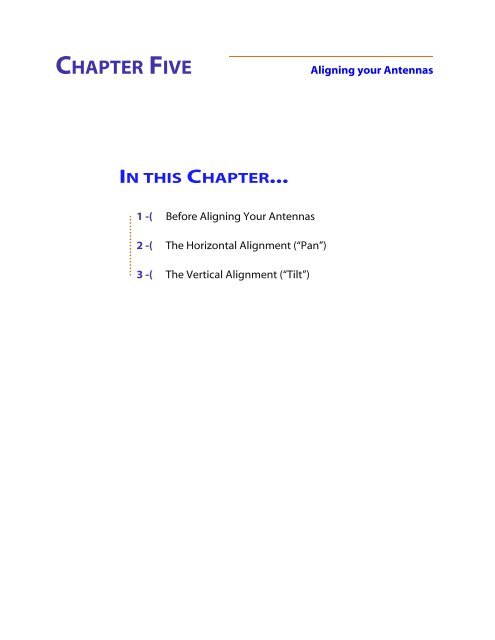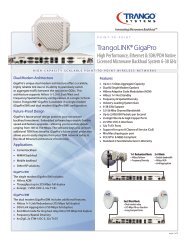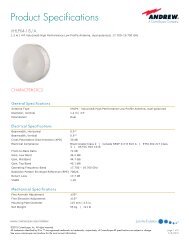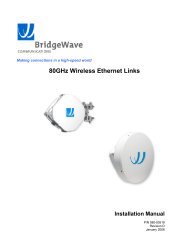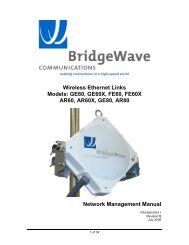Antenna Alignment - Meridian Microwave
Antenna Alignment - Meridian Microwave
Antenna Alignment - Meridian Microwave
You also want an ePaper? Increase the reach of your titles
YUMPU automatically turns print PDFs into web optimized ePapers that Google loves.
CHAPTER FIVE<br />
Aligning your <strong>Antenna</strong>s<br />
IN THIS CHAPTER...<br />
1 -( Before Aligning Your <strong>Antenna</strong>s<br />
2 -( The Horizontal <strong>Alignment</strong> (“Pan”)<br />
3 -( The Vertical <strong>Alignment</strong> (“Tilt”)
READ ME! Before Aligning your <strong>Antenna</strong>s<br />
W A R N I N G !<br />
Be fo re You Align Your Ante n n a s<br />
CHECK POWER TO THE RADIO HEADS & MULTIMEDIA CARDS<br />
Before aligning the antennas make sure you have fully powered both sides<br />
of the radio link and that all power LEDs are lit (one in the Radio Head and<br />
one for the Power Supply Module and each card in the Multimedia Hub).<br />
DID YOU V I S UA L LY AIM THE ANTENNAS AT EACH OT H E R ?<br />
If you visually aimed the antennas at each other, as advised on page 7, you<br />
m ay notice the pre s e n ce of a signal on the Signal Strength Me ter in the<br />
Radio Head. While the signal may be very weak, it’s an encouraging starting<br />
point that lets you know you’re receiving a signal from across the link.<br />
READ ME!<br />
DON’T BE ALARMED IF YOU DON’T IMMEDIAT E LY DETECT A SIGNAL ON<br />
THE METER. Parabolic antennas (especially 4’ in diameter or larger) focus<br />
the radio signal into a very narrow beam (
Aligning Your <strong>Antenna</strong>s : Horizontal Plane (Pan)<br />
1<br />
<strong>Antenna</strong> <strong>Alignment</strong>: Horizontal Plane (Pan)<br />
1st Azimuth Adjustment<br />
(Horizontal plane)<br />
Fine Azimuth<br />
Adjustment Rod<br />
(Horizontal plane)<br />
Signal Strength Meter<br />
at lower left corner of Radio Head<br />
(Measures receive signal)<br />
First you will “pan” or swing each antenna across a horizontal plane. To do this you must<br />
loosen the four bolts shown above as “1st Azimuth Ad j u s t m e n t”. Loosen the bolts just<br />
enough so that you can move the antenna side to side, but not enough so that the antenna<br />
begins to slide down the pipe mount.<br />
With the bolts loosened, SLOWLY move the antenna from left to right. IMPORTANT! Watch<br />
the Signal Strength Me ter as you swing the antenna to find the furthest left and right<br />
points where you first detect a signal. Go fully past any signal peaks to the beginning signal<br />
points in each direction. Otherwise you could be locking into side band (“side lobe”)<br />
energy instead of the main radio beam. Side lobes will show signal peaks, similar to the<br />
main beam, but they will be weaker signals that will give you enough gain to make a connection,but<br />
not enough for a truly reliable one.<br />
When you find the highest signal peak lock it in by tightening the four bolts of the “ 1 s t<br />
Azimuth Ad j u s t m e n t”. O n ce you have done this with both ante n n a s, turn the “ Fi n e<br />
Azimuth Adjustment Rod” on each antenna until you reach the highest signal peak. The<br />
fine adjustment rod is especially useful on long paths where even a slight movement of a<br />
few degrees could throw off the signal.<br />
N OTE! AS T RA N S M I TTERS ALL HAVE SLIGHTLY DIFFERENT GAIN FIGURES, S I G N A L<br />
STRENGTH VA LUES AT EACH END OF THE LINK MAY VA RY BY UP TO A V O LT. DO NOT<br />
EXPECT THE SAME READINGS AT BOTH ENDS OF THE LINK.<br />
CHAPTER FIVE: ALIGNING YOUR ANTENNAS<br />
37
Aligning Your <strong>Antenna</strong>s : Vertical Plane (Tilt)<br />
2<br />
<strong>Antenna</strong> <strong>Alignment</strong>: Tilt<br />
1st Elevation Adjustment<br />
Fine Elevation<br />
Adjustment Rod<br />
1st Elevation Adjustment<br />
Signal Strength Meter<br />
at lower left corner of Radio Head<br />
(Measures receive signal)<br />
After completing the horizontal alignment, find the “1st Elevation Adjustment” bolts and<br />
loosen both of them so that the antenna may be vertically moved.<br />
With the bolts loosened, S LOW LY move the antenna up and dow n . Wa tch the Signal<br />
S t rength Me ter as you move the antenna to find the furthest upwa rd and dow n wa rd<br />
points where you first detect a signal. IMPORTANT! Watch the Signal Strength Meter as<br />
you move the antenna to find the furthest upward and downward points where you first<br />
detect a signal. Go fully past any signal peaks to the beginning signal points in each direct<br />
i o n . Ot h e rwise you could be locking into side band (“side lobe”) energy instead of the<br />
main radio beam. Side lobes will show signal peaks, similar to the main beam,but they will<br />
be weaker signals that will give you enough gain to make a connection, but not enough<br />
for a truly reliable one.<br />
When you find the highest signal peak lock it in by tightening the two “1st Eleva t i o n<br />
Adjustment” bolts. Once you have done this with both antennas, turn the “Fine Elevation<br />
Adjustment Rod” on each antenna until you reach the highest signal peak. The fine adjustment<br />
rod is especially useful on long paths where even a slight movement of a fe w<br />
degrees could throw off the signal.<br />
N OTE! AS T RA N S M I TTERS ALL HAVE SLIGHTLY DIFFERENT GAIN FIGURES, S I G N A L<br />
STRENGTH VA LUES AT EACH END OF THE LINK MAY VA RY BY UP TO A V O LT. DO NOT<br />
EXPECT THE SAME READINGS AT BOTH ENDS OF THE LINK.<br />
CHAPTER FIVE: ALIGNING YOUR ANTENNAS<br />
38


